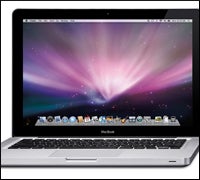 Apple’s new MacBook Click to enlarge. Source: Apple |
CUPERTINO, Calif. — Apple sure practices what it preaches. The company that once had the slogan “Think Different” has managed to take the Intel-based notebook in a new direction from its competition — one reason why it aims to continue gaining market share.
The company today introduced a total of four new notebooks here at its headquarters, offering expected performance improvements but sporting its biggest changes under the hood.
Apple showed a big sign of faith in graphics vendor nVidia (NASDAQ: NVDA), Apple is incorporating two of the company’s graphics processors in its laptops: the integrated graphics of the 9400M, plus the discrete, higher-performance 9600M GT. That marks some good news for nVidia, which has been battered lately with problems in its mobile graphics, although the problem was in the welding used to hold the heat sink in place and not the actual chips.
In a move to update what CEO Steve Jobs called Apple’s best-selling Mac line ever, the company introduced an overhaul to its MacBook consumer-oriented notebook. The new model features an all-aluminum design borrowed from the MacBook Pro line, representing a marked departure from the all-plastic casing of the current MacBooks.
The new model will feature nVidia 9400M graphics for a five-fold performance improvement, a 13.3-inch screen, a 2GHz Core 2 Duo processor, 2GB of RAM and a 160GB hard drive, for $1,299.
To help keep the MacBook’s momentum as its top seller, Apple also shaved $100 off its price, from $1,099 to $999.
On the higher end, Apple also unveiled two new MacBook Pro models: the $1,999 model will sport a 15.4-inch screen, a 2.4GHz Core 2 Duo processor, 2GB of memory and a 250GB drive, plus both nVidia graphics chips. The $2,499 model will use a 2.53GHz chip and come with 4GB of memory and a 320GB drive.
The MacBook Air, Apple’s ultra-thin notebook, got a facelift as well. With the addition of the 9400M, graphics performance is four times faster than the prior model. The notebook’s processor options remain the same — 1.6GHz and 1.8GHz — but storage options increase from 80GB to 120GB. Apple also will offer a 128GB solid state drive (SSD) option. The starting price for the MacBook Air remains $1,799.
The last item introduced was a new 24-inch display LED Cinema Display. It has three plugs, which makes it different from previous monitors. One is a power plug for the MacBook, one is a USB plug for daisy-chaining devices, and a third is a Mini Display Port. With these ports, you don’t need a separate power plug to power the Mac — it just plugs into the monitor.
The resolution is 1920×1200 pixels, with a built-in iSight camera, microphone and stereo speakers, plus a three-port USB 2.0 hub. It will be available in November for $899.
Different under the hood
All of the notebooks will sport the same Mini Display Port video, which replaces a Digital Visual Interface port across the whole line. Prior generations had different ports with each model. More importantly, they will have common designs: the same monitor, the same glass trackpad and the same all-metal design.
Thanks to a new design process in which the body of the notebook is cut from a solid block of aluminum, the new, all-metal MacBook and MacBook Pros use 60 percent fewer parts and are much lighter for dumping their plastic cases. The company also is continuing its environmental push, eliminating arsenic, BFRs, mercury and PVC.
Page 2: MacBooks go greener; some choice thoughts on Apple’s next steps
Page 2 of 2
[cob:Pull_Quote]”As proud as we are of what we’ve put in these new MacBooks, we’re just as proud of the things we left out,” Jobs said.
The new MacBooks have been given an EPEAT Gold rating from the Environmental Protection Agency for being environmentally friendly, the company said. In addition, far fewer parts also mean fewer points of failure and less breakage.
“In many ways, I think it is more beautiful internally than externally, and that just shows our care in design,” Jonathan Ive, senior vice president of design at Apple, said in a video shown during today’s presentation.
Apple’s changes are across the board. It has eliminated the mouse button on its trackpad, replacing it with a larger, glass trackpad not unlike the iPhone surface. Users can resize and reshape using multiple fingers, just like they do with Apple’s popular mobile phone.
The notebooks’ screens are now end-to-end in the case, so the 15.4-inch notebook lid is a full 15.4 inches. Open the lid and it’s all screen. Additionally, the LED screen needs no warm-up, unlike the display used on so many notebooks.
After his presentation, Jobs held a question-and-answer session with Phil Schiller, senior vice president of worldwide marketing, and Tim Cook, chief operating officer.
 |
| Source: Reuters |
To kick things off, Jobs, ever the comedian, addressed the false CNN report that he’d suffered a heart attack with a slide that read “110/70 – Steve’s blood pressure.”
“That’s all we’re going to say about it,” he added, to much laughter from the audience.
The trio address a number of questions about Apple’s next steps, although Jobs said that because the company’s earnings are next week, Oct. 21, anything financially related could not be discussed.
For example, Jobs was candid about whether Apple would support Blu-Ray DVD.
“Blu-ray is just a bag of hurt,” he said.
“I don’t mean from a consumer point of view,” he added. “It’s just that the licensing is so complex. We’re waiting for it all to settle down.”
As for netbooks, he said the proliferation of the lightweight, low-power and low-cost notebook PC category is “a nascent market — just getting started.”
It doesn’t seem Apple will be going into touchscreens anytime soon, either, like HP recently did with its TouchSmart PC.
“We’ve experimented with a touchscreen, and so far, it hasn’t made a lot of sense,” Jobs said.


